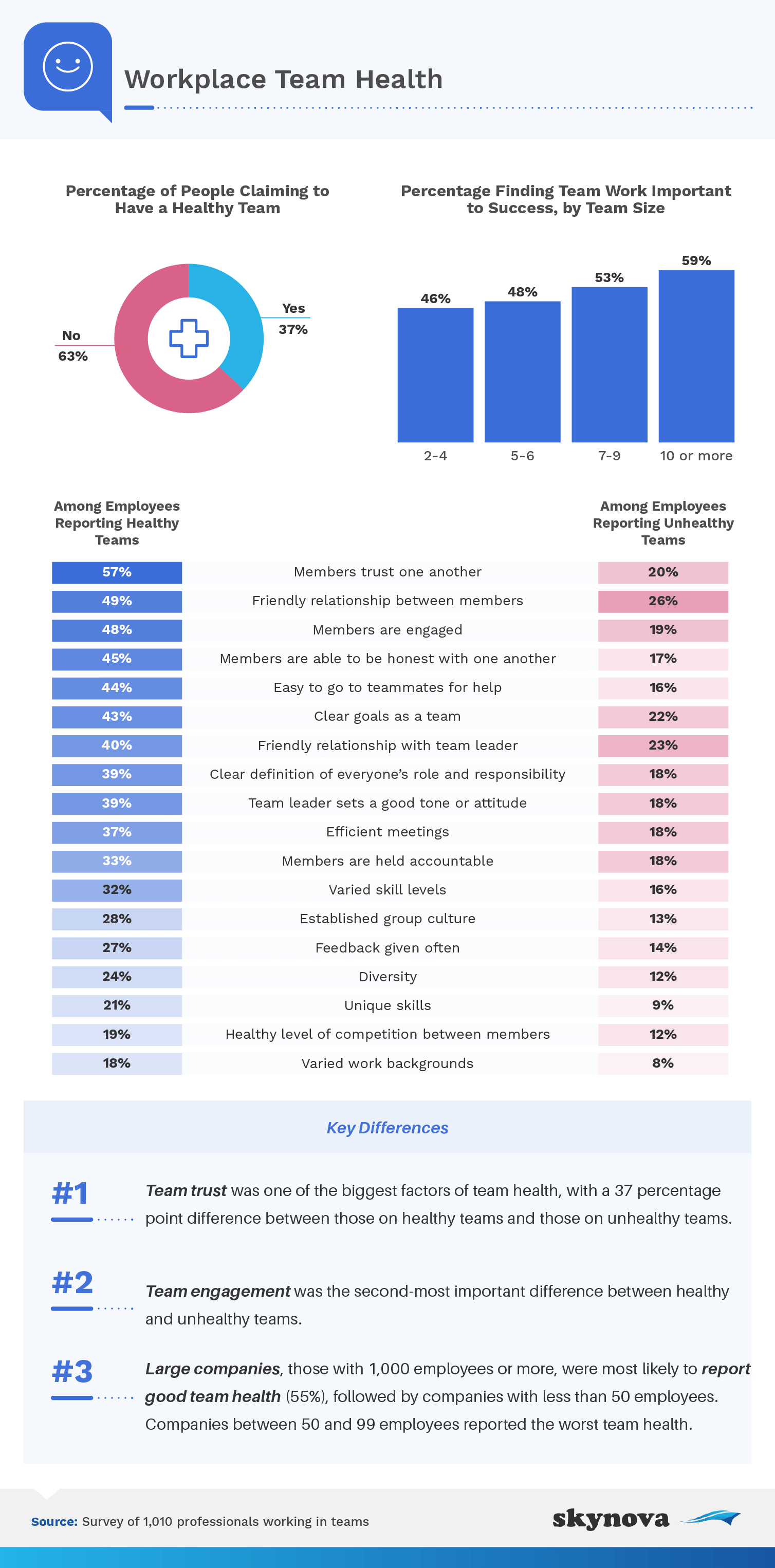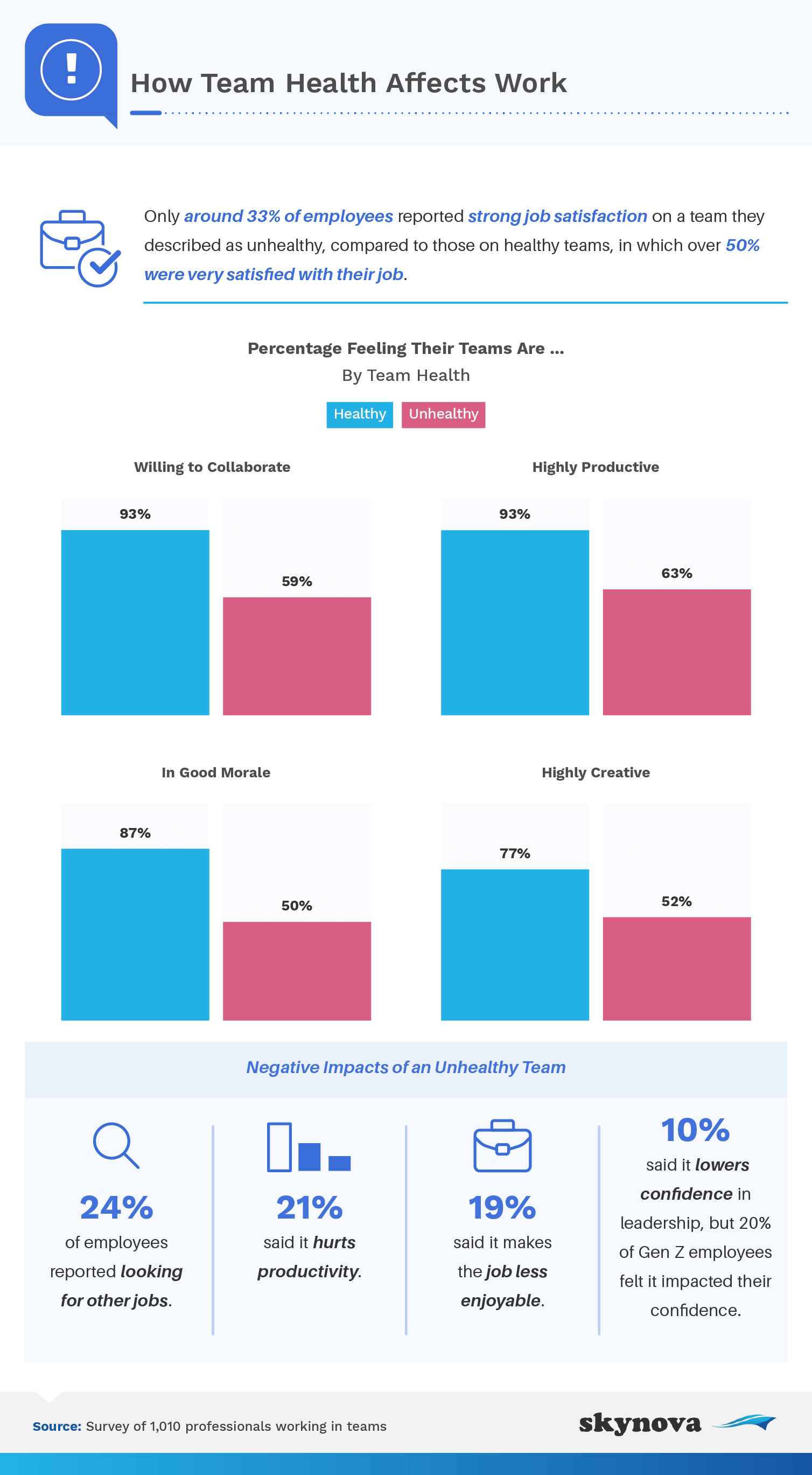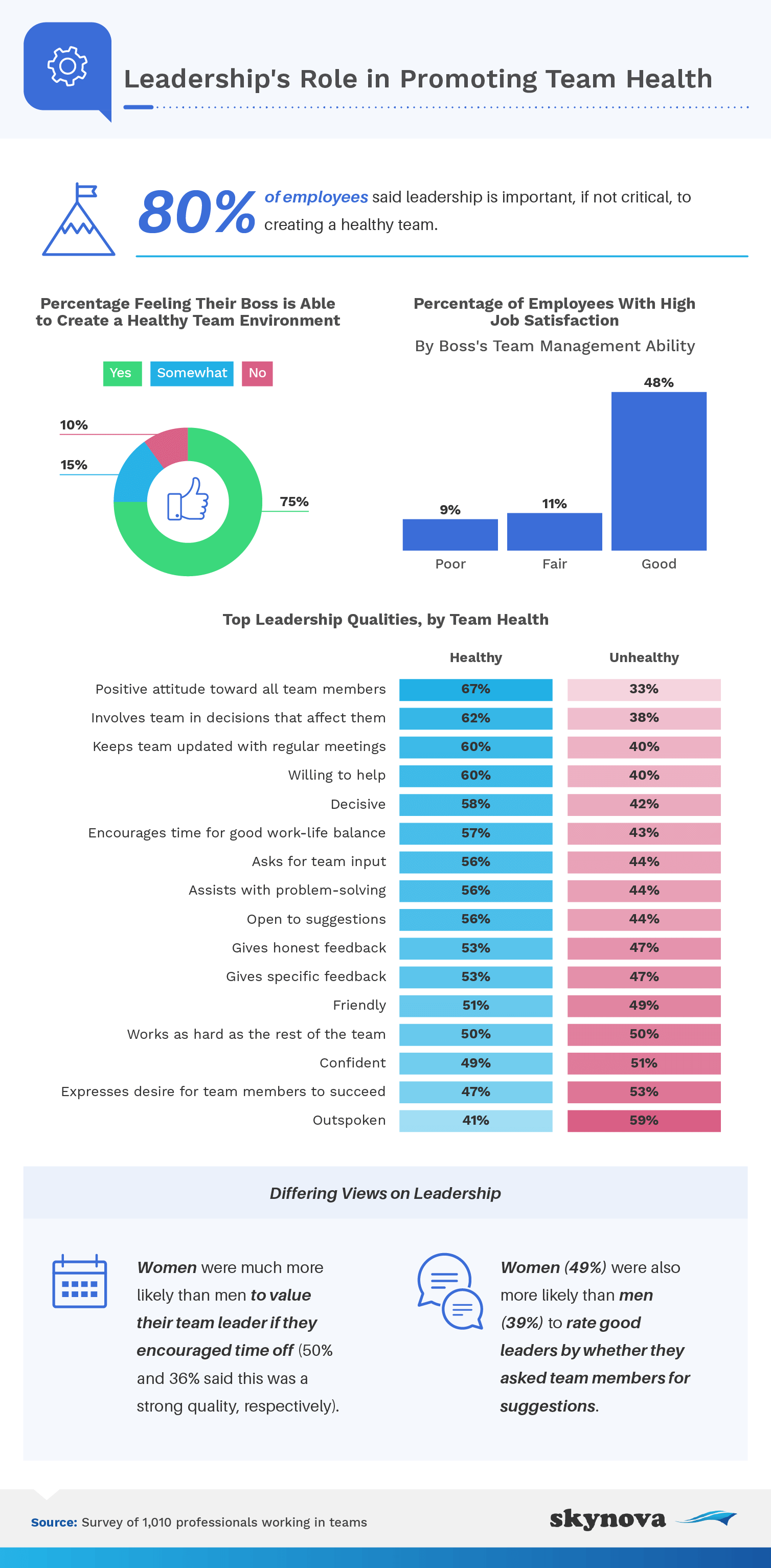
|
Companies all over the world are constantly searching for ways to improve productivity. Whether they are hoping to boost efficiency and morale or working to create more opportunities for collaboration, a workplace’s overall performance can rely heavily on members of the team working together to achieve a common goal. We wanted to explore how employees felt about the current state of their workplace teams and whether they felt that they were performing optimally or not.
Additionally, since leadership is key to any organization, we wanted to know what roles managers played in supporting a healthy team environment and just what those leaders were capable of in terms of affecting team dynamics. We surveyed over 1,000 professionals working in teams to find out how employees measured their team health and what the benefits or consequences were across variables like business size and gender. Read on to find out what we discovered.
We asked respondents to report on their team’s health; namely, how optimally they felt their team was performing as a unit. Respondents could also indicate if they felt that members of that unit were hindering team collaboration and productivity. We analyzed these groups to determine how many professionals worked on healthy versus unhealthy teams and asked them to identify the qualities their team possessed for more nuanced data.

Around 63% of respondents answered that they were on a team they considered to be unhealthy, compared to 37% who cited their teams as healthy. This statistic doesn’t bode well for the workplace, as many employees found that teamwork was critical to job success, with a well-adjusted team becoming even more important as teams grew in size.
Unfortunately, our survey also shows that employees who work on unhealthy teams lack the sense of camaraderie and trust that healthy teams possess. Employees who considered themselves part of a healthy team were nearly three times as likely to trust one another than those who reported an unhealthy team. They were also almost twice as likely to have a friendly relationship with other team members and felt comfortable communicating with honesty – both markers of healthy co-worker relationships.
Respondents who worked on healthy teams reported higher rates of collaboration, productivity, team morale, and creativity than those who considered their team environments unhealthy. The greatest impact of team health was on team morale, where we found a 37 percentage point difference between healthy and unhealthy teams. Bad morale can be a drag on any team, and according to our findings, similarly affects both men and women. Only around 33% of employees reported strong job satisfaction on a team they described as unhealthy, compared to those on healthy teams, in which over 50% were very satisfied with their job.
These findings are supplemented by another recent study, which found that if professionals find meaning in their work, they are likely to be much happier and more efficient in their job.

Nearly a quarter of those on unhealthy teams reported looking for other work, and over 20% answered that their team’s unhealthiness negatively impacted productivity. Though less common, a much more severe consequence of a team riddled with issues was that it affected how employees perceive their companies and the confidence they have in their leadership.
Respondents found leadership to be the foundation upon which a healthy, harmonious work team is built. Nearly three-quarters of respondents answered that their bosses were capable of creating such an environment and detailed a multitude of ways they achieved that, from their inclusion of team members in decision-making processes, to their decisiveness, friendliness, and confidence. However, one of the key differences in leadership on a healthy team versus an unhealthy one was the presence of an equitable, positive attitude shown toward all team members. The widest percentage point gap between healthy and unhealthy teams was reported for this leadership quality.

As shown by the data, strong leadership has a significant positive impact on the tone and dynamics of a work team, just as poor leadership has negative consequences. Outspokenness was the most commonly reported characteristic among leaders of unhealthy teams; which perhaps explains why positivity and consensus-based decision-making were lacking.
Some other interesting findings from our study relate to the ways in which employees deal with problematic team members. For example, when employees had a problem with a co-worker on their team, only 37% reported them to a supervisor. Thirty-eight percent of employees said they’ve either ignored or done nothing about a co-worker who was causing unhealthy conditions on their team, whereas 1 in 3 employees had reported their manager or boss for creating a toxic team environment.
From tension between employees to poor leadership, issues that affect the dynamics and collaboration of a team should be flagged to management swiftly, as they could have serious consequences for a company’s bottom line. On a more positive note, employees who work well with their team members, and operate within a system of trust, engagement, and honesty will experience much higher morale and productivity. With so much emphasis on the role of leadership in ensuring team health, cultivating and training strong leaders is key to any company’s overall success.
Skynova provides small businesses with the sophisticated online tools they need to stay organized, professional, and competitive. Send invoices, track timesheets, or use more advanced tools for tasks like accounting to keep your business on track. Skynova also conducts in-depth research and data projects diving into topics that matter to business owners, including studies on the intersection of business and technology, industry trends, and top methods for building better, healthier teams. Visit skynova.com today for the resources and tools you need to help your business and your teams thrive.
We surveyed 1,010 employed professionals who reported working on a team of multiple people. Respondents ranged in age from 19 to 69, and the mean age was 39 with a standard deviation of 10.52 years. Fifty-eight percent of our respondents identified as men, and 42% identified as women. We asked respondents to report broadly on how healthy they felt their teams were, as well as to describe what factors contribute to healthy teams and leadership in order to explore the nuances of team health. Respondents who missed the attention-check questions were disqualified.
Survey data has certain limitations related to self-reporting. These limitations include telescoping, exaggeration, and selective memory. We didn’t weight our data or statistically test our hypotheses. This was a purely exploratory project that examines the way health is described and valued in a team setting.
Are you interested in implementing change in your own work team? Sharing our study could help you and your co-workers get on the same page. However, please share for noncommercial purposes only and don’t forget to link back to this page to give our contributors credit.